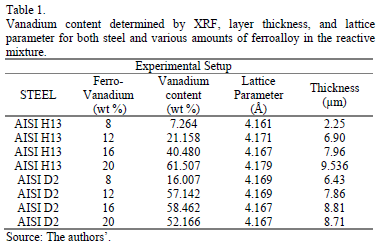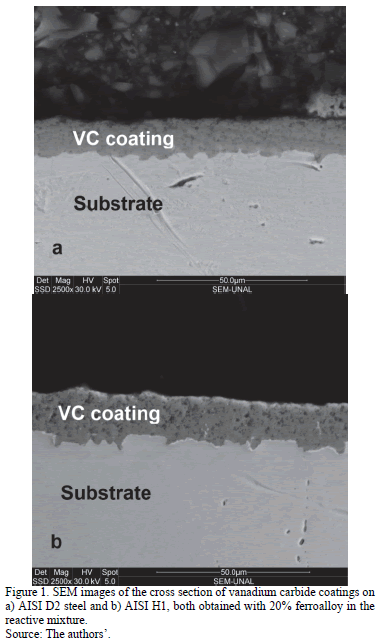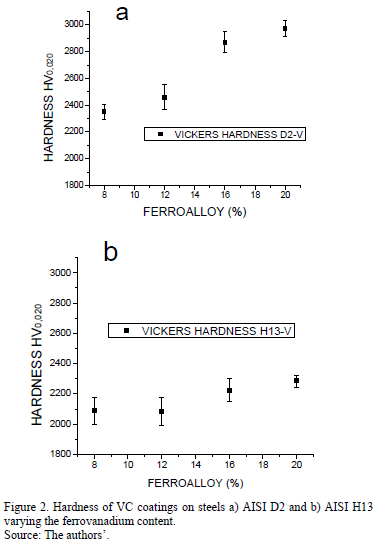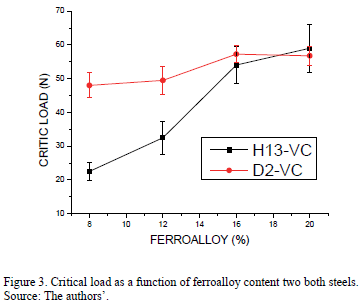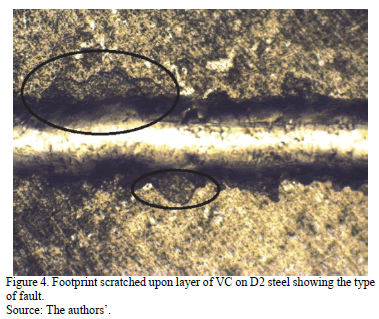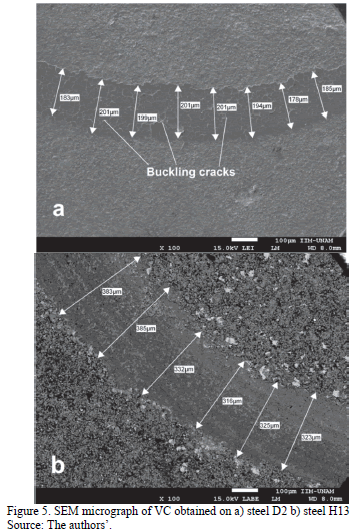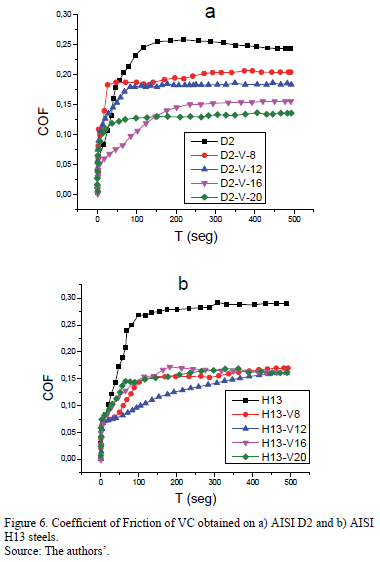Serviços Personalizados
Journal
Artigo
Indicadores
-
 Citado por SciELO
Citado por SciELO -
 Acessos
Acessos
Links relacionados
-
 Citado por Google
Citado por Google -
 Similares em
SciELO
Similares em
SciELO -
 Similares em Google
Similares em Google
Compartilhar
DYNA
versão impressa ISSN 0012-7353
Dyna rev.fac.nac.minas vol.82 no.194 Medellín nov./dez. 2015
https://doi.org/10.15446/dyna.v82n194.49243
DOI: http://dx.doi.org/10.15446/dyna.v82n194.49243
Effect of V addition on the hardness, adherence and friction coefficient of VC coatings produced by thermo-reactive diffusion deposition
Efecto de la adición de V en la dureza, adherencia y el coeficiente de fricción de recubrimientos de VC producidos mediante deposito termo-reactiva/difusión
Fredy Alejandro Orjuela-Guerrero a, José Edgar Alfonso-Orjuela b & Jhon Jairo Olaya-Flórez c
a Facultad de Ingeniería, Fundación Universitaria Los Libertadores. Bogotá, Colombia. faorjuelag@libertadores.edu.co
b Departamento de Física, Grupo de Ciencia de Materiales y Superficies, Universidad Nacional de Colombia. Bogotá, Colombia. jealfonsoo@unal.edu.co
c Departamento de Ingeniería Mecánica y Mecatrónica, Universidad Nacional de Colombia. Bogotá Colombia. jjolayaf@unal.edu.co
Received: February 17th, 2015. Received in revised form: May 29th, 2015. Accepted: October 22th, 2015.
Abstract
Vanadium carbide (VC) coatings were deposited on AISI H13 and AISI D2 steel substrates via thermo-reactive deposition/diffusion (TRD) in order to evaluate their mechanical properties as a function of the vanadium content. The coatings were produced with different percentages of ferrovanadium in the reactive mixture. The chemical composition of the coatings was determined through X-ray fluorescence (XRF), the crystal structure was analyzed using X-ray diffraction (XRD), the morphology was characterized using scanning electron microscopy (SEM), the hardness was measured with nanoindention, and the tribological behavior was studied using the ball-on-disc test. The XRF analysis indicated that the coatings grown on D2 steel decreased the atomic percentage of vanadium when the coating was made with 20% ferrovanadium. The XRD analysis established that the coatings were polycrystalline, with a cubic structure. The SEM images revealed that the coatings grown on D2 steel were more compact than those grown on H13 steel. Finally, the wear tests established that the friction coefficient decreased with an increase of vanadium in the coating.
Keywords: Coatings, Thermo-reactive deposition, crystal structure, Mechanical properties
Resumen
Se produjeron recubrimientos de carburo de vanadio (VC) sobre sustratos de acero AISI H13 y acero AISI D2 mediante deposito termo-reactiva/difusión (TRD) con el fin de evaluar sus propiedades mecánicas como una función del contenido de vanadio. Los recubrimientos se producen con diferentes porcentajes de concentración de ferrovanadio. La composición química de los recubrimientos se determinó mediante fluorescencia de rayos X (XRF), la estructura cristalina se analizó utilizando difracción de rayos X (XRD), la morfología se caracterizó usando microscopía electrónica de barrido (SEM), la dureza se midió a través de nanoindentaciòn, y las propiedades tribológicas mediante la prueba de bola sobre disco. El análisis XRF indicó que los recubrimientos crecidos en acero D2 disminuyó el porcentaje atómico de vanadio cuando el recubrimiento se produce con 20% de ferrovanadio. El análisis XRD estableció que los recubrimientos eran policristalinos, con una estructura cúbica. Las imágenes de SEM revelaron que los recubrimientos crecidos en acero D2 eran más compactos que los crecidos en el acero H13. Finalmente, las pruebas de desgaste establecieron que el coeficiente de fricción disminuyó con un aumento de vanadio en el recubrimiento.
Palabras clave: Recubrimientos, deposito Termo-reactivo, estructura cristalina, propiedades mechanics
1. Introduction
Typical protective coatings applied by the steel industry to reduce the effect of wear on equipment exposed to mechanically aggressive environments are hard layers of carbides, nitrides, borides, and oxides. These coatings are deposited using techniques such as physical vapor deposition (PVD), chemical vapor deposition (CVD), thermal spray, and thermo-reactive deposition/diffusion (TRD). TRD has the advantage that it can deposit dense and homogenous layers that can be applied to steels containing carbon that has percentages higher than 0.3% [1]. TRD is also used for coating surfaces with hard materials in fluidized beds, molten salt baths, or powder. In addition, TRD is a simple and economical alternative for the production of layers of binary carbides such as VC, NbC, TiC, or Cr7C3, which are formed by the reaction between the carbon atoms of the substrate and the atoms of the carbide-forming elements (CFE). These elements are dissolved in molten borax and are then added to a mixture of ferroalloy and aluminum [1,2]. The properties of carbide coatings deposited on steels are: excellent adhesion, and wear and corrosion resistance. Because the layer growth depends on the diffusion of carbon, the process requires high temperatures, ranging from 800 to 1250°C, in order to maintain an adequate deposition rate. Carbide coating thicknesses ranging from 4 to 15 microns are obtained with processing times between 10 minutes and 8 hours, depending on the bath temperature and steel type [1-2].
Vanadium is an excellent CFE because it has a lower free energy of carbide formation and its free energy of formation of oxides is higher than that of B2O3 [3]. Vanadium carbide (VC) is a chemically stable compound with a cubic crystalline structure; it melts at high temperatures and has a high degree of hardness [4-6]. The study and characterization of the effect of the addition of vanadium on mechanical properties such as hardness, friction coefficient, and adherence of vanadium carbides deposited via TRD has not been explored sufficiently, but it has great potential in industrial applications such as sheet forming, machine elements subject to wear, and sliding tools for machining and molding [6-9]. The wear resistance and hardness of layers containing carbides obtained via TRD have been studied [10-14], and the layers have been reported to have good tribological properties. Fan et al. [5-7] recently studied the mechanism of growth and the microstructure of carbides prepared using TRD, analyzed the effect of the carbon activity on the preparation of these coatings on AISI H13 and AISI 9Cr18 steel, and developed a mathematical model to explain this effect. The aim of the present paper is to study the effect of the atomic percentage of vanadium on the growth of vanadium carbide coatings on two kinds of steel with different atomic carbon contents and to study the hardness, friction coefficient, and adherence of these coatings.
2. Experimental Procedure
2.1. Preparation of the substrates
VC coatings were deposited onto substrates of AISI H13 and AISI D2 tool steel using the TRD technique. These substrates were prepared with a 16 mm diameter and a 3 mm thickness, were subsequently polished with 600 grit sandpaper, and then washed in an acetone solution for five minutes in an ultrasound device. The hardness of the annealed AISI D2 and the annealed AISI H13 were 223 HB and 200 HB, respectively. The vanadium ferroalloy had a high content of Si (2.5%), V (60%), Al (1.5%), and C (0.45%).
2.2. Growth of the coatings
The TRD treatment was carried out at a temperature of 1050°C for 4 hours. The reaction mixture is formed by 4 wt% aluminum, and various weight percentages of ferrovanadium concentration with the same chemical composition, from 8 to 20 wt%, combined with borax pentahydrated (Na2B4O7 5H2O) to complete the mixture. The samples were quenched in water without agitation. The time and temperature conditions ensured the complete austenitization of the steel used in this study without excessive distortion or abnormal grain growth, which produces mechanical changes.
2.3. Chemical and structural characterizations
The chemical composition of the layers was evaluated using a MagixPro Philips PW-2440 XRF spectrometer equipped with a rhodium tube with 4 kW maximum power. This device has a sensitivity of 200 ppm (0.02%) for heavy metals. Semi-quantitative analysis was performed using IQ software. The specimens were ultrasonically washed in an acetone solution for 5 minutes before each measurement.
The microstructure of the coatings was determined using a PANalytical X'Pert PRO diffractometer using Bragg Brentano geometry with Cu Ka radiation (l=1.5405Å) between 10° and 90° with steps of 0.02°, a current of 40 mA, and a potential difference of 45 kV.
Analysis of the morphology and thickness of the coatings was performed using a JEOL 7600F electron microscope and a FEI Quanta 200 electron microscope. The images were obtained using secondary and backscattered electrons that were accelerated with 15 kV at 5.000X. The samples were polished so they had a mirror finish and were attacked with Villela to reagent their surface microstructure.
2.4. Wear resistance
The friction coefficient of the coatings was measured on a CETR-UMC-2 ball-on-disk tribometer using an Al2O3 ball (6 mm in diameter) as a sliding counterpart in air at room temperature. The sliding speed was 100 mm/s, and the load was fixed at 4 N. At the beginning of the test, the maximum Hertzian contact pressure was 1.5 Pa and the radius of the contact circle was 1.5 × 10-3 m, assuming a Young's modulus (E) of 380 GPa and a Poisson's ratio (v) of 0.23 for Al2O3, as well as E = 380.4 GPa and v = 0.23 for the VC coating, obtained using the nano-indentation test. The maximum shear stress was 165 MPa, located at a depth of ~1 mm below the coating surface.
2.5. Adherence and hardness
Taking into account the loss of carbon on the surface of the substrate due to the process of outward diffusion, and with the aim of determining how much the D2 and H13 steels support the layer of vanadium carbide, the degree of adhesion of the carbide layer formed on the two steels was determined using scratch tests, in order to determine the critical load where the first phenomenon of cohesive and interfacial failure at the edges of the scratch test appeared, as specified by the standard DIN-EN 1071-3 [15]. The average lengths of the defects were taken from the beginning of the scratch to the first spallation defect, and the critical load was determined taking into account that a graduated load was used, from 0 to 90 N, along the length of the 9 mm scratch and with an indenter velocity of 10 mm/min.
The hardness of the coatings was determined in accordance with ISO standard 14577 by using an NTH2 nanoindenter from CSM Instruments that was outfitted with a Berkovich indenter tip. A linear load was used with an approximate speed of 2000 nm/min, loading rate of 60 mN/min, maximum load of 30 mN, and loading dwell time of 15 s. The hardness was measured on the surface of the coatings and was measured in five different zones for each sample.
3. Results and discussion
3.1. Chemical composition and structural characterization
Table 1 shows the XRF, thickness, and lattice parameter results of the coatings deposited on the two steels. It shows the vanadium percentages in the coatings as a function of the ferrovanadium used in the coating process. In the chemical analysis, it is possible to observe that the vanadium increases lineally with the ferrovanadium concentration on the H13 substrate, while in the D2 substrate the vanadium percentage exhibits very different behavior. Initially it increases from 15% to 60% wt at low concentrations of ferrovanadium in the reactive mixture. There is no change from between 12% to 16%, and it slightly decreases at a 20% ferrovanadium concentration. The behavior at high concentrations of ferrovanadium is related to the carbon activity, which will be explained below. Table 1 also shows the thickness of the coatings as a function of the concentration of ferrovanadium. The results allow it to be established that the thickness of the coatings grown on the D2 substrate is higher at all ferrovanadium concentrations, with the exception of 20%, than those grown on the H13 substrate.
XRD analysis, presented in a previous paper [16], revealed that the vanadium carbide formed is polycrystalline with a face-centered cubic (FCC) structure, of NaCl type, in which the vanadium atoms occupy the FCC phase lattice and the carbon atoms occupy the interstitial positions between the vanadium (PDF card 01-073-0476) on both substrates. Moreover, the relative intensities of the (200) and (111) planes are higher in the vanadium carbide coatings grown on H13 substrates than those grown on D2 substrates, and the relationship between these planes is approximately 0.8 in both cases. These results indicate that the vanadium carbide grew with a higher degree of crystallinity in the substrate with a lower concentration of carbon atoms. Fig. 1 shows the cross section of the VC coatings deposited on D2 and H13 steels; the coating grown on D2 steel is more compact.
3.2. Hardness
Fig. 2a-b shows the values of the hardness of the VC coatings that were deposited on AISI H13 and AISI D2 tool steels. In coatings deposited on AISI D2, higher hardness values are exhibited in the samples manufactured with 20% ferroalloy, with values close to 3000 HV. These hardness values were higher than those reported in the literature [4, 6-13, 16], in which hardness values of about 2372 HV and 2270,9 HV were reported.
For vanadium carbide coatings deposited on AISI H13 steel, the highest hardness value was for the sample fabricated with 20% ferroalloy; however, this value is close to the average value of 2300 HV. Furthermore, one can observe that the type of steel significantly determines hardness results for these coatings. This can be explained by the amount of carbon necessary to form the carbide on each substrate, which sets the value of the carbon activity (Ac). This, in turn, significantly affects the solubility of carbon in the crystal structure of the carbide-forming element, and hence can influence the nucleation and growth of the vanadium carbide grains [7,14,17,18]. The AISI D2 steel can be characterized by a columnar microstructure of elongated grains. The high carbon content and its activity are capable of reducing the outward diffusion of carbon atoms on the growth surface. Under these manufacturing conditions, a low nucleation rate occurs, which hinders the continued growth of the coating. Furthermore, for AISI H13 steel it is possible to achieve an equiaxed grain microstructure, due to the decrease in the carbon content, which allows the value of the carbon activity to increase, favoring perpendicular growth so that it is approximately equal to the horizontal growth rate. Thus, an increase in the nucleation density reduces the grain size, and the formation of a compact microstructure is favored.
3.3. Adherence
Fig. 3 shows the adhesion results obtained for the coatings. It can be observed that critical loads are exhibited for the coatings produced with 20% ferroalloy, and lower critical loads were exhibited for vanadium carbide coatings on H13 steel produced with 8% ferroalloy. In general, all coatings exhibited a cohesive failure type characterized by ductile behavior in the scratch trace. Also, a small fracture area of the layer was observed, but not in the interphase substrate-coating, i.e. the phenomenon of widespread delamination in the coating was not present, allowing one to conclude that the coatings exhibit a high degree of adhesion and simultaneously good cohesion, since delamination failures or spallation were generally very mild and were present under relatively high critical loads.
Adhesion test results were characterized over a wide area by a buckling type deformation; see Fig. 4. This type of failure is related to the intrinsic fragility of the coating, and is observed in thick layers [18]. For all samples, the failure is buckling on the perpendicular scratching axis. This type of crack is characteristic of a solid Hertziana, where the fracture is fragile when a blunt indenter is used. It should also be noted that the coatings are produced by carbon diffusion from the substrate surface towards the coating, which may promote adhesion values of over 50 N, which are used for cutting tool applications [14,19-22].
3.4. Friction coefficient
Fig. 5, shows the SEM image taken with secondary electrons on the samples with 16 % ferroalloy. In the image it can be observed that there are cracks produced by a buckling of the tread surface, which is produced by application of a normal load on the sample. The results established that the wide track was possibly obtained by a plastic mechanism and oxidation with air.
The results for the friction coefficient (COF) for each of the layers studied are shown in Fig. 6. The results establish that for all coatings, the COF is improved relative to that of the substrate. In the coatings deposited on AISI D2 steel, the influence of the percentage of ferroalloy on the value of the COF is more evident, since it can be observed that increasing the ferroalloy content in the reactive mixture reduces the coefficient of friction to close to a value of 0.12. This behavior is possibly related to the formation of more compact and homogeneous layers. Additionally, samples deposited with 20% ferroalloy have the highest hardness and adhesion values.
The increased COF for the first 100 seconds of the test, observed in Fig. 6, can be explained by the plow mechanism, since when a load is applied to the system, the mechanical energy is dissipated by the deformation of the surfaces during sliding contact; if a hard roughness penetrates the softer surface, the plastic flow generated by the plow creates an increasing resistance to the movement and an increase in the friction coefficient [18,21]. The wear type that was exhibited by the carbide coatings was a combination of abrasive wear and adhesion wear. Adhesive wear is a form of deterioration that occurs between two surfaces in sliding contact, and it occurs when two surfaces are in contact, forming strong bonds between them. Due to the relative movement, bonds are either released and transferred between surfaces, or remain as free particles [18]. In Fig. 5, the optical micrographs of the typical signs of wear on these coatings can be observed. Also, the presence of alumina (Al2O3) particles that adhered to the surface thereof can be seen. For all samples, adhesive and abrasive wear mechanisms due to debris or loose particles are present. [20,21]. The friction coefficient, adhesion, and hardness values obtained in the present research project are low and are comparable to hard coatings produced through techniques such as chemical vapor phase deposition. The coatings produced in the present research project lead to an excellent opportunity to produce coatings for cutting tools, improving their mechanical and tribological properties, enabling them to increase durability for fieldwork.
4. Conclusions
Vanadium carbide coatings were produced on AISI H13 and AISI D2 steel, varying the ferrovanadium content in the synthesis process. These coatings had a FCC cubic phase with orientation mainly in the planes (200) and (111). Upon increasing the vanadium content in the coating, the following was observed:
- An increase in hardness, which reached values close to 3000 HV in the coatings deposited on AISI D2.
- An increased coating adhesion, with the highest values of critical load higher than 50 N. This value can be explained by the process of diffusion of carbon on the coating surface and the chemical reaction with the vanadium.
- The friction coefficient reached values close to 0.12, which can be explained by increased hardness and adhesion.
Acknowledgements
The authors gratefully acknowledge the financial support granted by the Departamento Administrativo de Ciencia, Tecnología e Innovación - COLCIENCIAS through project No. 338-2011. The authors acknowledge the support of the Universidad Nacional de Colombia (UNAL) and the Universidad "Los Libertadores".
References
[1] Arai, T., Harper, S., Thermoreactive Deposition/Diffusion Process, ASM Handbook, 4, ASM International, Materials Park, OH, USA, p. 448, 1991. [ Links ]
[2] Liu, X., Wang. H., Li, D. and Wu, Y., Study on kinetics of carbide coating growth by thermal diffusion process, Surface & Coatings Technology 201, pp. 2414-2418, 2006. DOI: 10.1016/J.SURFCOAT.2006.04.028 [ Links ]
[3] Arai, T., Fujita, H., Sugimoto, Y. and Ohta, Y., Diffusion carbide coatings formed in molten borax systems, J. Mater. Eng., 9(2), pp. 183-189, 1987. [ Links ]
[4] Aguzzoli, C., Figueroa, C.A., de Souza, F.S., Spinelli, A. and Baumvol, I.J.R., Corrosion and nanomechanical properties of vanadium carbide thin film coatings of tool steel. Surface & Coatings Technology. 206, 2725-2731, 2012. DOI: 10.1016/J.SURFCOAT.2011.11.042 [ Links ]
[5] Fan, X.S., Yang, Z.G., Zhang, C. and Zhang, Y.D., Thermo-reactive deposition processed vanadium carbide coating: growth kinetics model and diffusion mechanism. Surface & Coatings Technology. 208, pp. 80-86, 2012. DOI: 10.1016/j.surfcoat.2012.08.010 [ Links ]
[6] Fan, X.S., Yang, Z.G., Zhang, C., Zhang, Y.D. and Che, H.Q., Evaluation of vanadium carbide coatings on AISI H13 obtained by thermo-reactive deposition/diffusion technique. Surface & Coatings Technology. 205, pp. 641-646, 2010. DOI: 10.1016/j.surfcoat.2010.07.065 [ Links ]
[7] Fan, X.S., Yang, Z.G., Xia, Z.X., Zhang, C. and Che, H.Q., The microstructure evolution of VC coatings on AISI H13 and 9Cr18 steel by thermo-reactive deposition process. Journal of Alloys and Compounds. 505, pp. L15-L18, 2010. DOI: 10.1016/j.jallcom.2010.06.064 [ Links ]
[8] Castillejo, F.E. and Olaya J.J., Recubrimientos de VC y NbC producidos por DRT: Tecnología Económica, eficiente y ambientalmente limpia. Ciencia e Ingeniería Neogranadina. 22(1), pp. 95-105, 2012. ISSN 0124-8170 [ Links ]
[9] Castillejo, F.E., Marulanda, D. and Olaya J.J., Estudio de recubrimientos de carburos ternarios de Niobio-Vanadio producidos sobre acero D2 usando la técnica de deposición por difusión termorreactiva. Revista Latinoamericana de Metalurgia y Meteriales. 34(2), pp. 230-239, 2014. ISSN: 0255-6952 [ Links ]
[10] Sen, S. and Sen, U., Sliding wear behavior of niobium carbide coated AISI 1040 steel. Wear. 264, pp. 219-225, 2008. DOI: 10.1016/j.wear.2007.03.006 [ Links ]
[11] Oliveira, C.K.N., Benassi, C.L. and Casteletti, L.C., Evaluation of hard coatings obtained on AISI D2 steel by thermo-reactive deposition treatment. Surface & Coatings Technology. 201, pp. 1880-1885, 2006. DOI: 10.1016/j.surfcoat.2006.03.036 [ Links ]
[12] Gee, M.G., Gant, A., Hutchings, I., Bethke, R., Schiffman, K., Van Acker, K., Poulat, S., Gachon, Y. and von Stebut, J., Progress towards standardisation of ball cratering. Wear. 255, pp. 1-13, 2003. DOI: 10.1016/S0043-1648(03)00091-7 [ Links ]
[13] Castillejo, F.E., Marulanda, D., Olaya J.J. and Alfonso, J.E., Wear and corrosion resistance of niobium-chromium carbide coatings on AISI D2 produced through TRD, Surface and Coatings Technology, 254(15), pp. 104-111, 2014. DOI: 10.1016/j.surfcoat.2014.05.069 [ Links ]
[14] Orjuela A., Rincón, R. and Olaya, J.J., Corrosion resistance of niobium carbide coatings produced on AISI 1045 steel via thermo-reactive diffusion deposition, Surface and Coatings Technology, 259, pp. 667-675, 2014. DOI: 10.1016/j.surfcoat.2014.10.012 [ Links ]
[15] DIN EN 1071-3, Methods of test for ceramic coatings, determination of adhesion and other mechanical failure modes by a scratch test. 2005. [ Links ]
[16] Castillejo, F., Marulanda, D., Rodriguez, O. and Olaya, J.J., Electrical furnace for producing carbide coatings using the thermoreactive deposition/diffusion technique. DYNA, 78(170), pp. 192-197. 2011, ISSN: 0012-7353 [ Links ]
[17] Castillejo, F.E., Olaya, J.J. and Alfonso, E., Wear resistance of vanadium-niobium carbide layers grown via TRD. DYNA 81(184), pp. 1-2. 2014. DOI: 10.15446/dyna.v82n193.46657 [ Links ]
[18] Orjuela, A., Resistencia a la corrosión en recubrimientos de carburo de vanadio y carburo de niobio depositados con la técnica TRD. Tesis de Maestría, Universidad Nacional de Colombia, Colombia, [En línea]. 2013. Disponible en: http://www.bdigital.unal.edu.co/10727/1/300281. [ Links ]
[19] Adachi, K.A. and Hutchings, I.M., Wear-mode mapping for the micro-scale abrasion test, Wear, 255, pp. 23-29, 2003. DOI: 10.1016/S0043-1648(03)00073-5 [ Links ]
[20] Sen, U., Friction and wear properties of thermo-reactive diffusion coatings against titanium nitride coated steels Materials and Design 26, pp. 167-174, 2005. DOI: 10.1016/j.matdes.2004.05.010 [ Links ]
[21] Devia, D., Mecanismos de desgaste en herramientas de conformado con recubrimientos de TiAlN por medio de sistemas PAPVD. Tesis de Doctorado. Universidad Nacional de Colombia, Facultad de Minas Medellín, Colombia, 2012. [ Links ]
[22] Taktak, S., Ulker, S. and Gunes, I., High temperature wear and friction properties of duplex surface treated bearing steels. Surface & Coatings Technology 202, pp. 3367-3377, 2008. DOI: 10.1016/j.surfcoat.2007.12.015 [ Links ]
F.A. Orjuela-Guerrero received his BSc. Eng. in Mechanical Engineering in 2010, and his MSc. in Mechanical Engineering in 2013, both from the Universidad Nacional de Colombia, Bogotá, Colombia. He has worked in mechanical design programs and projects in the metal mechanic industry. In 2013 his is as he became a professor in the Engineering Department, at the Universidad Los Libertadores, Bogotá, Colombia, as well as a professor in the Universidad Distrital Francisco José de Caldas, Bogota, Colombia. Since 2014, he has been a collaborator to a materials science and surfaces group that works with the publication of scientific papers. ORCID: 0000-0003-4987-473X
J.E. Alfonso-Orjuela, completed his BSc. degree in Physics in 1987 and his MSc. degree in Science - Physics in 1991, both from the Universidad Nacional de Colombia, Colombia. In 1997 he completed his PhD in Science - Physics in the Universidad Autonoma de Madrid, Spain. He has taught at the Universidad Nacional de Colombia as a Professor since 2000, where his research has been focused on material science, particularly on thin film processing as well as performance characterization, and has studied thin film optical, electrical and mechanical properties. RCID: 0000-0003-4200-8329
J.J. Olaya-Flórez, is an associate professor at the Departamento de Ingeniería y Mecatrónica in the Universidad Nacional de Colombia, Bogotá, Colombia. He conducts research in the general area of development and applications of thin films deposited by plasma assisted techniques, corrosion, and wear. He received his PhD in 2005 from the Universidad Nacional Autonoma de México - UNAM, Mexico. ORCID: 0000-0002-4130-9675













